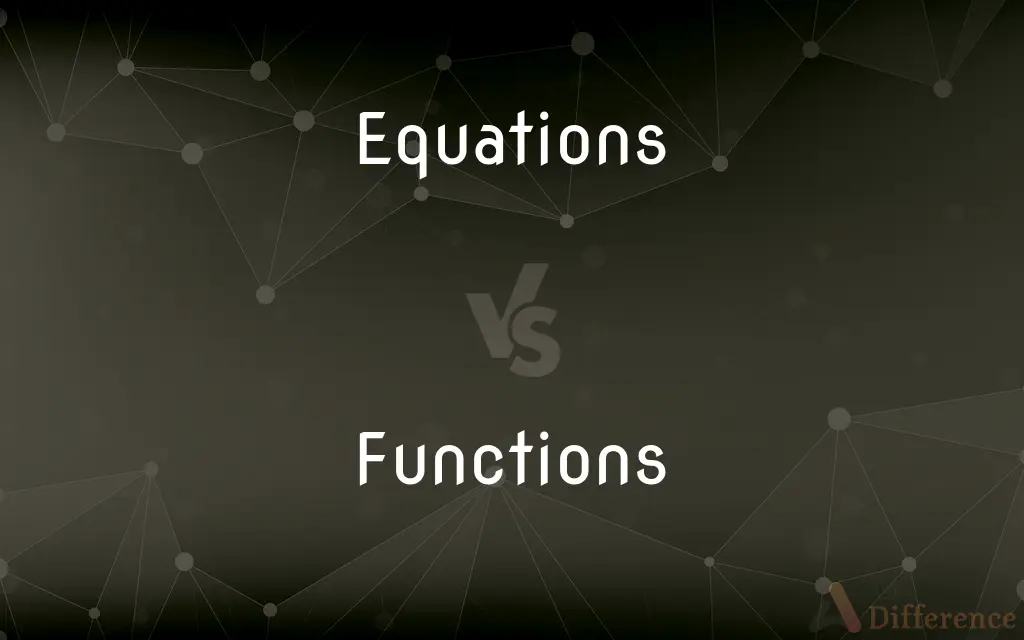Equations vs. Functions — What's the Difference?
By Tayyaba Rehman — Published on December 12, 2023
Equations express a relationship between quantities; Functions map input to output, often represented by equations.

Difference Between Equations and Functions
Table of Contents
ADVERTISEMENT
Key Differences
Equations are mathematical statements that showcase the relationship between two expressions, often using an equals sign. Functions, on the other hand, describe how one quantity depends on another, often presented using equations.
In Equations, you can see the direct relationship between two or more terms. For example, the equation
x+5=10 establishes that when 5 is added to x, the result is 10. Functions, while they can be expressed using equations, have an inherent input-output structure.
The realm of Equations is vast and isn't just limited to the equals sign. Inequalities, for instance, are also equations. Functions primarily relate to the idea of dependency, where a set of inputs relates to a set of outputs. A function can be represented by multiple equations but still revolves around the same core principle.
Equations can be simple, like y=2x, or complex, representing physical laws or intricate relationships. Functions, regardless of their complexity, always operate on the principle of assigning each input to one unique output. For instance, in the function f(x)=x2 , each value of x will produce a unique square value.
ADVERTISEMENT
In summary, while both Equations and Functions play fundamental roles in mathematics, they serve different purposes. Equations highlight relationships, and Functions emphasize dependency and mapping from one set to another.
Comparison Chart
Definition
Mathematical statements showcasing a relationship.
Relate inputs to outputs, often via equations.
Representation
Often use an equals sign.
Use notation like f(x).
Nature
Showcase relationships between terms.
Describe dependency between sets.
Core Principle
Equality or relationship between terms.
Mapping of each input to a unique output.
Compare with Definitions
Equations
Expressions set equal to each other.
The equation x−3=7 can be solved to find x.
Functions
Mathematical relationships mapping inputs to outputs.
The function f(x)=2x doubles any number you input.
Equations
Mathematical statements that show relationships.
The Pythagorean theorem is one of the most famous Equations in geometry.
Functions
Represented using specific notations like f(x).
In the function g(t)=t2, t is squared.
Equations
Can represent physical laws or principles.
Einstein's equation E=mc2 revolutionized physics.
Functions
Each input corresponds to a single unique output.
In trigonometric Functions, sin(0)=0.
Equations
Establish connections between mathematical terms.
Quadratic Equations have a degree of two and can be solved for x.
Functions
Show how quantities depend on one another.
The volume of a cylinder is a function of its radius and height.
Equations
Can be inequalities, not just equalities.
In the world of Equations, x>5 is an inequality.
Functions
A person's role or occupation
In my function as chief editor.
Equations
The act or process of equating or of being equated.
Functions
(Biology) The physiological activity of an organ or body part
The heart's function is to pump blood.
Equations
The state of being equal.
Functions
(Computers) A procedure within an application.
Equations
(Mathematics) A statement asserting the equality of two expressions, usually written as a linear array of symbols that are separated into left and right sides and joined by an equal sign.
Functions
An official ceremony or a formal social occasion
Disliked attending receptions and other company functions.
Equations
(Chemistry) A representation of a chemical reaction, usually written as a linear array in which the symbols and quantities of the reactants are separated from those of the products by an arrow or a set of opposing arrows.
Functions
Something closely related to another thing and dependent on it for its existence, value, or significance
Growth is a function of nutrition.
Equations
A complex of variable elements or factors
"The world was full of equations ... there must be an answer for everything, if only you knew how to set forth the questions" (Anne Tyler).
Functions
A variable so related to another that for each value assumed by one there is a value determined for the other.
Equations
Plural of equation
Functions
A rule of correspondence between two sets such that there is exactly one element in the second set assigned to each element in the first set. Also called mapping.
Functions
To have or perform a function; serve
Functioned as ambassador.
Functions
To deal with or overcome the challenges of everyday life
For weeks after his friend's funeral he simply could not function.
Functions
Plural of function
Functions
Can be visualized using graphs on coordinate planes.
Linear functions result in straight-line graphs.
Common Curiosities
Can an Equation represent a Function?
Yes, equations like y=2x can represent functions, where y is a function of x.
What are Equations?
Equations are mathematical statements that express relationships, often using an equals sign.
Are all Functions represented by Equations?
Not all, but many functions are represented by equations to showcase the input-output relationship.
Can Equations represent real-world scenarios?
Yes, equations can model various real-world situations, from physics to finance.
How are Functions typically graphed?
Functions are graphed by plotting input-output pairs on a coordinate plane.
Are Functions always continuous?
No, functions can be discontinuous, meaning they might have breaks or jumps.
Do Equations always use an equals sign?
No, equations can also be inequalities like x>5.
Can Equations have multiple solutions?
Yes, some equations, like quadratic equations, can have multiple solutions.
What are Functions?
Functions describe how one quantity depends on another, mapping inputs to outputs.
What's the difference between linear Equations and linear Functions?
Linear equations represent straight-line relationships. Linear functions are specific cases where one variable depends linearly on another.
How are Functions used in real life?
Functions model scenarios where one quantity depends on another, like distance being a function of time.
Do Functions always have a single output for each input?
Yes, by definition, each input of a function has a unique output.
Is every mathematical relationship a Function?
No, not all relationships are functions; they must satisfy the unique output for each input criterion.
Share Your Discovery

Previous Comparison
Baryons vs. Mesons
Next Comparison
New York Cheesecake vs. Chicago CheesecakeAuthor Spotlight
Written by
Tayyaba RehmanTayyaba Rehman is a distinguished writer, currently serving as a primary contributor to askdifference.com. As a researcher in semantics and etymology, Tayyaba's passion for the complexity of languages and their distinctions has found a perfect home on the platform. Tayyaba delves into the intricacies of language, distinguishing between commonly confused words and phrases, thereby providing clarity for readers worldwide.












































